At 2 to 3 m in length the black mamba is the largest venomous snake in all of Africa. It is also the most feared snake due to its size, speed, fast acting venom and its timid nature which sees them act aggressively in defence if they are cornered with no opportunity to escape. The snake is gun barrel grey, not black. It actually gets its name from the colour of the inside of its mouth. Rather ominously the head is coffin shaped. The black mamba has straight rigid fangs that deliver its deadly neurotoxic venom.
Vote for the fact you find most fascinating
The black mamba can inject up to 400 mg of its neurotoxic venom into its victim with one bite. However, only 10 to 15 mg is required to kill a man so even a scratch by one of these snakes can prove deadly.
The black mamba is not interested in prey that is already dead. Instead they will seek out their own quarry such as birds and small mammals which they find whilst foraging in trees.
The black mamba lays up to 14 eggs in the protection of a cavity such as a vent in a termite mound. After 2.5 to 3 months the 35 to 50 cm young mambas hatch fully armed with functioning fangs and venom.
If threatened the 2.5 to 3 m black mamba will rear up by as much as 1/3 off the ground. It will then spread its narrow hood, open its mouth to reveal the black interior and strike at the intruder if they approach further.
Black mambas have the quickest acting venom of all snakes in Africa which can kill a man in 5 hours if untreated. However, treatment is now available so most victims survive.
The venom of the black mamba is neurotoxic, it attacks the nervous system by stopping neurons (nerve cells) from passing electrical or chemical cues to another one (it blocks the synaptic gap). This causes gradual paralysis which leads to the inability to breath followed by cardiac arrest.
A black mamba is quick, reaching speeds of up to 10 kph, but due to its size it can’t compete with the speed of a sand snake.







